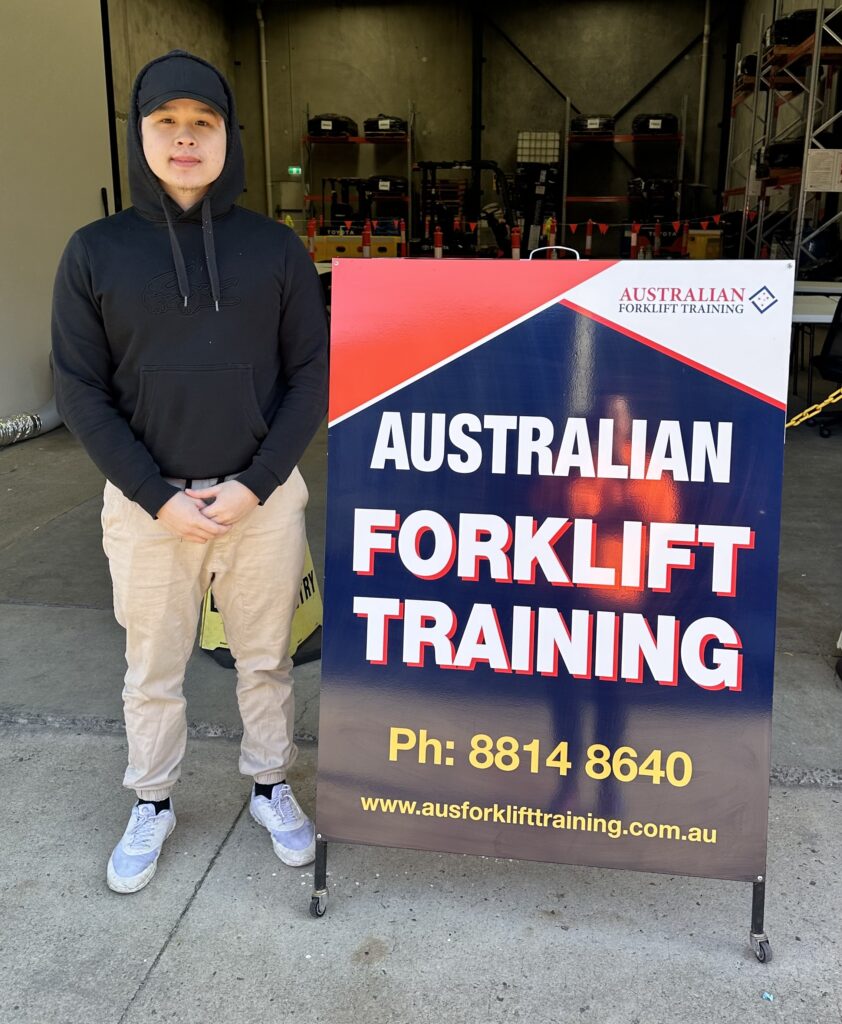What Is the Difference Between LF and LO Forklift Licence?
Understanding what is the difference between LF and LO forklift licence is crucial for anyone involved in operating forklifts in Australia. LF licences are for general forklifts like standard, counterbalance, and high-reach forklifts. In contrast, LO licences are specific to order-picking forklifts and turret trucks. This article will detail each type and highlight their key distinctions to help you choose the right licence for your needs.
Key Takeaways
The LF licence is required for general forklift operations, while the LO licence is specialised for order-picking forklifts used in logistics.
LF operators remain behind controls during operation, whereas LO operators move with the load, highlighting differences in operational procedures.
Both LF and LO licences must be renewed every five years, emphasising the importance of ongoing training and compliance to maintain workplace safety.
Overview of Forklift Licences in Australia

In Australia, it is a mandatory legal requirement to obtain a forklift licence before operating these vehicles. Falling under the category of High-Risk Work licences, both LF and LO designations are crucial to ensure that operators are properly trained and adhere to safety standards in the logistics industry.
The two main types of forklift licences available include the LF licence—Licence to Perform High-Risk Work with Forklift Trucks—and the LO licence—Licence to Operate Order-Picking Forklifts. The former (LF) covers operation for standard tasks using common counterbalance forklifts, while an operator would need an LO licence specifically for handling order-picking trucks prevalent in warehouses and distribution environments.
Holding a valid licence as a certified operator signifies adherence to safety guidelines and dedication to professional development within this field. Effective training minimises the risk of mishaps significantly. Lacking such accreditation can result not only in dangerous situations, but also severe financial repercussions due through fines or other legal consequences. Pursuing appropriate certification according to one’s job duties serves both individual career aspirations as well as broader compliance goals.
What is an LF Forklift Licence?
An LF licence authorises the operation of forklift trucks designed to perform high-risk work, but it does not include permissions to operate order-picking forklifts. The scope of this licence extends to commonly used types such as standard, counterbalance, and high-reach models.
In order to drive an LF forklift equipped with a mast and an elevating load carriage safely and legally, you must hold a valid LF forklift licence. Gaining this qualification can enhance employment prospects in environments like warehouses or construction sites where such expertise is required. Particularly if complemented by completing comprehensive training courses specific to forklifts.
Types of Forklifts Covered by LF Licence
An LF licence encompasses a range of forklift types. These include the standard models frequently seen in warehouses and distribution centres, which are equipped with forkarms to securely lift and move materials.
The counterbalance forklift is another type included under an LF licence’s purview. This vehicle features a rear-mounted weight that offsets heavy loads at the front, making it adept at moving substantial weights over compact areas.
High-reach forklifts that excel at elevating cargo to considerable heights also fall under the requirement of holding an LF licence to operate them. Ensuring safe use of these machines is essential for both efficiency and safety standards in workplace environments.
What is an LO Forklift Licence?
Possessing an LO forklift licence is essential for those intending to operate an order picking forklift truck, particularly within logistics operations. This specific type of licence is required when performing tasks that involve retrieving orders from high shelving units, which necessitate the elevation of both the operator and the cargo.
With an LO forklift licence, individuals are authorized to handle turret trucks as well as order-picking forklifts. These machines differ from conventional forklifts in their ability to transport operators alongside the load, thereby increasing efficiency during order-picking procedures. Individuals working in distribution centers and warehouses find this licence particularly vital.
Types of Forklifts Covered by LO Licence
An LO licence is required for operating specific types of forklifts that are essential in warehousing and logistics operations, including order-picking forklifts. These vehicles enable the operator to be raised up to the level of high shelves, thereby facilitating effective order picking and item placement.
Turret trucks which are engineered to maneuver narrow aisles and lift entire pallets also require an operator with an LO licence. The acquisition of this licence certifies that operators have received proper training to handle the distinct challenges posed by these specialized forklifts.
Key Differences Between LF and LO Forklift Licences

The distinctions between LF and LO forklift licences primarily revolve around the specific types of machinery they are applicable to and the operational techniques required. An LF licence is suitable for operating a range of general forklifts, including standard models, counterbalance versions, and high-reach forklifts. In contrast, an LO licence specifically pertains to order picking forklifts such as stock pickers and turret trucks.
There’s a notable difference in how operators manage their positions relative to the load. Operators with an LF licence remain stationary at the controls during lifting operations. Those holding an LO licence are designed to accompany the load—ascending along with it because control mechanisms ascend concurrently with the load carriage. This reveals significant differences in safety measures and handling procedures between these two categories of forklift operation.
Lastly, both lf-licensed and lo-licensed personnel must renew their certifications every five years. The renewal process requires proof that they can adeptly handle their respective machines while maintaining stringent safety regulations—a measure put in place to uphold persistent proficiency among operators across all types of lifts within this field.
The Importance of Proper Training and Licensing

Adhering to workplace safety regulations is essential, and acquiring a forklift licence through proper training plays a vital role in this. The skills obtained from the training ensure that forklift operators can handle equipment safely and efficiently, decreasing the likelihood of incidents such as load mishaps or collisions with pedestrians.
Respecting licensing requirements is also crucial to circumvent significant fines and legal complications. Licences classified under LF and LO must be renewed every five years. Otherwise, operators may need to undertake the entire training course again. This requirement serves both as an assurance of ongoing competency among operators and an enforcer of strict adherence to safety compliance within the workplace.
Obtaining certification after completing a training course offers personal growth benefits by providing individuals with advanced skills needed for high-risk work environments, which enhances their career prospects while reinforcing job stability. Continuous professional development, including regular updates on new safety measures and operational methods, are typically offered by registered training organisations, keeping forklift drivers current in best practices related to their field.
How to Obtain an LF or LO Forklift Licence
To acquire an LF or LO forklift licence, a sequence of steps must be followed. Individuals seeking licensure must first reach the minimum age requirement of 18 and undergo appropriate training with an accredited institution. This training encompasses hands-on practical sessions as well as written and numerical exercises to ensure they have a thorough understanding and competence.
Subsequently, candidates are required to display their mastery through evaluations conducted by certified assessors. This includes both theoretical knowledge assessments and practical performance tests. After demonstrating adequate proficiency in these areas, individuals become eligible to apply for their respective forklift licences.
As part of the application process for their high-risk work licence, which permits them to legally operate lo-forklifts among other types of lifting machinery, applicants need to present valid identification along with passport-sized photographs. The provision of these documents facilitates the proper processing and eventual granting of the necessary certification essential for conducting high risk work involving operation of various kinds of forklifts safely within regulated environments.
Benefits of Holding Both LF and LO Licences

Holding both LF and LO forklift licences significantly enhances job opportunities across various sectors. Dual licences demonstrate a broader skill set, making employees more appealing to potential employers. This versatility is particularly advantageous in industries requiring flexible forklift operations.
The combination of LF and LO licences enables operators to handle both heavy loads and order-picking tasks efficiently. This dual capability increases operational efficiency and ensures adaptability to different job requirements.
For operators looking to advance their career in logistics and warehousing, holding both licences is a valuable asset.
Summary
Understanding the differences between LF and LO forklift licences is crucial for anyone involved in forklift operations. The LF licence covers general forklift trucks, including standard, counterbalance, and high-reach forklifts, while the LO licence is specific to order-picking forklifts and turret trucks. Proper training and licensing not only enhance workplace safety, but also ensure legal compliance and professional development.
By obtaining both LF and LO licences, operators can significantly broaden their job opportunities and demonstrate a comprehensive skill set. Whether you’re looking to start a career in the logistics industry or advance in your current role, understanding and obtaining the appropriate forklift licences is a critical step towards achieving your career goals.
Frequently Asked Questions
What is the difference between an LF and an LO forklift licence?
Understanding the distinction between an LF licence and an LO licence is essential for adhering to operational regulations. An LF licence authorises individuals to operate general types of forklifts, which include counterbalance models, while an LO licence is particularly designated for those who will be operating order-picking forklifts and turret trucks.
How long are LF and LO forklift licences valid for?
Forklift licences for both LF and LO must be renewed every five years to ensure ongoing competency.
What types of forklifts can I operate with an LF licence?
Possessing an LF licence permits the operation of traditional forklifts, including counterbalance and high-reach models.
What is required to obtain an LF or LO forklift licence?
To secure a licence for an LF or LO forklift, it’s mandatory to undergo appropriate training and pass both the theoretical and practical exams. You must furnish suitable identification along with passport-sized photographs.
Adhering to these prerequisites guarantees that you are adherent to regulations and maintain safety standards while handling forklift operations.
What are the benefits of holding both LF and LO licences?
Possessing LF and LO licences expands job prospects and showcases a wider array of skills, simultaneously offering versatility in overseeing various forklift tasks.
<a href=”https://www.activesearchresults.com/”><img src=”https://www.activesearchresults.com/images/asrbutton.png” alt=”Active Search Results” width=”88″ height=”31″ border=”0″ /></a>


